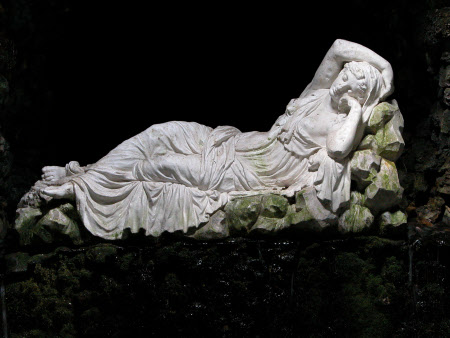Nymph of the River Stour (after the 'Belvedere Cleopatra')
probably John Cheere (London 1709 – London 1787)
Category
Art / Sculpture
Date
1748 - 5 Jun 1760
Materials
Painted (enamelled) white lead
Measurements
865 x 1700 mm
Place of origin
London
Order this imageCollection
Stourhead, Wiltshire
NT 562876
Summary
Painted (enamelled) white lead sculpture, Nymph of the River Stour, probably by John Cheere (1709 – London 1787). Lead statue of based on the antique. The original marble statue, Cleopatra (or Ariadne) is in the Vatican, Rome (Haskell and Penny 1981, no. 24) and was first recorded on 2 February 1512 as having being acquired by Pope Julius II from Angelo Maffei and taken to the Belvedere and installed as a fountain; by the 1530s the niche was created to look like a grotto, although by 1704 Pope Clement XI expressed concern of the damage being caused by the water. Other lead versions are at West Wycombe Park and Southill, Bedfordshire.The Stourhead copy is not documented but most probably by John Cheere and mentioned in a letter from William Hoare to Henry Hoare II, 5 June 1760. See also William Hoare's pastel in the Little Dining Room of Stourhead House (NT 730719), which is presented more horizontal than the original, without the 'asp' bracelet. Walpole writes in 1762 'Cleopatra, but without the Asp, to represent a Nymph. See also Montfaucon, 'L'Antiquité expliqué...'(1719) held in Stourhead Library. See also poetic inscription on stone slab, Alexander Pope's translation of Castiglione NT 562953 (STO.SC.102)
Makers and roles
probably John Cheere (London 1709 – London 1787), sculptor
References
Haskell and Penny 1981: Francis Haskell and Nicholas Penny, Taste and the Antique, The Lure of Classical Sculpture 1500 - 1900, New Haven and London, 1981, no. 24, p.184 The Man at Hyde Park Corner : Sculpture by John Cheere, 1709-1787 exh. cat [Terry Friedman and Timothy Cliffford], Temple Newsam, Leeds, 15 May - 15 June and Marble Hill House, 19 July - 8 September 1974, no. 3
